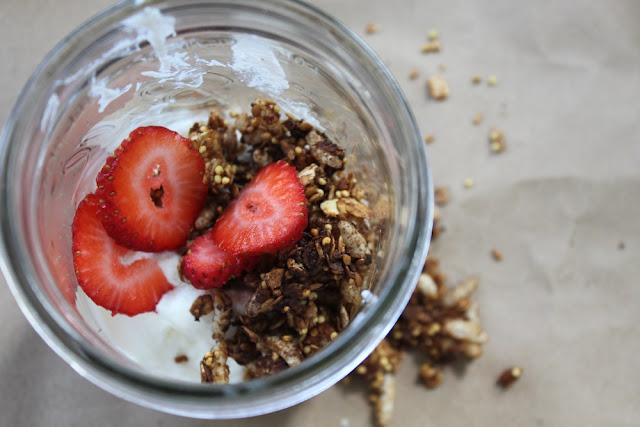Since writing my yogurt post quite a while back, I have continued to try to find easier ways to make yogurt. Not that it was that hard to begin with... I'm just lazy. And I really like yogurt. So I try to find easier ways to make it. Also, I have developed a love for greek yogurt... and good grief that stuff is expensive! I finally found some at Sprouts for $3 a quart, but still. Greek yogurt is an expensive habit.
So of course I set out to find a way to make it at home, cheaper. If you care what the costs come up to, read on. If not, skip this next paragraph.
I can buy milk for $2.60 a gallon at Crest, and I use about 1 quart per batch of yogurt. (I don't measure it exactly. I never measure anything exactly. I am so sorry. But that is probably not going to change.) So each 1 quart batch of homemade yogurt is about $.65. Not bad when you consider that a quart of store-bought plain yogurt generally runs around $1.50, if you're lucky! But even greater things are in store for my money-saving yogurt venture. When I strain my yogurt and make it into greek yogurt, I end up with about half as much greek yogurt as I had plain yogurt (1 pint). So, I can make 1 pint of greek yogurt for $.65, when the same amount of store-bought greek yogurt costs $1.50 at the cheapest place I found it! Plus, I don't just have greek yogurt, I also have 1 pint of whey that I strain off of it, which I use in place of buttermilk. Win, win, and cheap win.
So, now as to how I actually make it.
Because I am lazy, I don't like standing over a hot stove stirring my heating milk to make sure it doesn't burn... so I heat it in the microwave. The reason to heat up the milk to very hot is to kill any existing bacteria that might be in it, so that our introduced bacteria can thrive with no competition. So I stick my bowl of a quart of milk in the microwave for about 6 minutes, or until it is steaming.
Then, I let it cool down, so that when I introduce the new bacteria they don't get killed immediately. I let my bowl of milk sit with the microwave door open for about 40 minutes, stirring it occasionally. You want to be able to hold your pinky finger in the milk for ten seconds without being burned. But you don't really want it to get any colder than that, because it has to be warm enough for the bacteria to grow. If you are using a thermometer, you want it to stay in the 90-120 F range. (32-48C)
I then stir about 3 Tb of yogurt into the milk. This can be store bought yogurt (live culture), or the last bit of your last batch of homemade yogurt. I used the last of some greek yogurt I bought at Sprouts for this batch. I then put a lid on my bowl of milk, put it back in the microwave, and tucked a nice fluffy towel around it to keep it warm. My house was warm enough that this was all it needed to stay warm all night, but if you are worried about it cooling off, you could put a bottle of hot water in there with it. I did that over the winter. I have also put the yogurt bowl in a cooler with a towel and a couple of bottles of hot water. Whatever it takes to keep it warm, at about the same temperature it is now.
Then... leave it. The longer you leave it, the stronger it gets. I left my batch overnight, about 12 hours. (8pm to 8am). You can peek at your yogurt to see if it's where you want it. You want it to be about this consistency:
As you can see, it's still fairly runny, but it is more "yogurty" than "milky." (I'm all for the technical terms).
At this point, you can just stir this yogurt up and pop it in the fridge, and you have plain yogurt. But if you want greek yogurt, you have one more step. If you are going to make greek yogurt DO NOT STIR it. Instead, pour it into a strainer over a bowl. I use a yogurt strainer, but in the past I have used cheesecloth in a colander, or even a loose weave cloth napkin (serviette) in a colander. Place your straining yogurt in the fridge, and leave it until it is as thick as you desire. I strained this batch for 5 hours (until 1pm). This yielded a consistency pretty similar to store bought greek yogurt, and strained about half of the volume out as whey. If you leave it for longer, it turns into greek yogurt dip (or spread), and even longer gives you cream cheese! Of course, the volume continues to go down.
When it is like you want it, spoon the yogurt into a container for storage (I use a glass jar), and if you are keeping the whey (which I recommend), pour it into another jar. Stir the yogurt vigorously to break up any chunks and to give it a creamy consistency.
 |
| whey and yogurt |
Yum.
This recipe was shared on: Real food Wednesday, and Thank Your Body Thursday.













